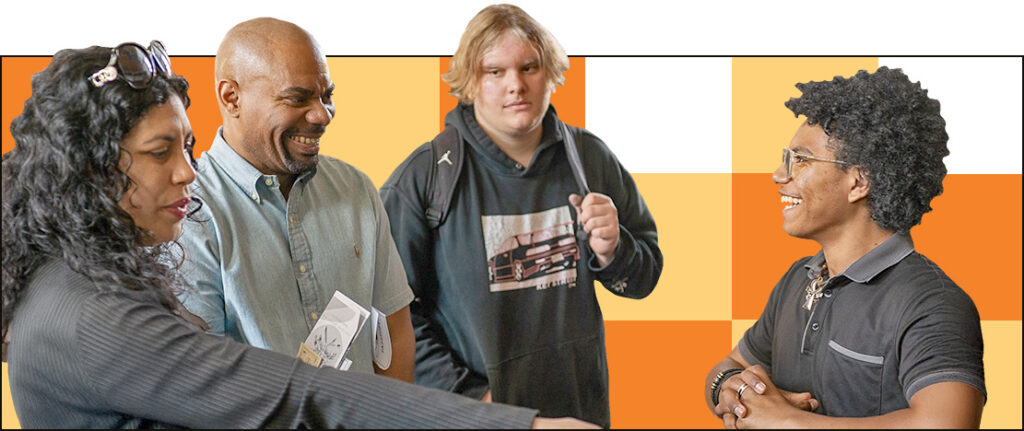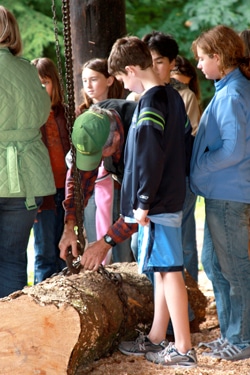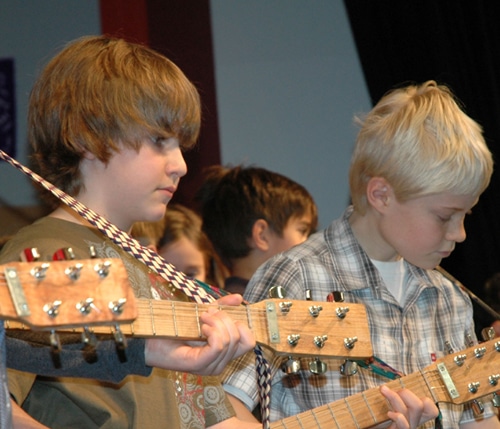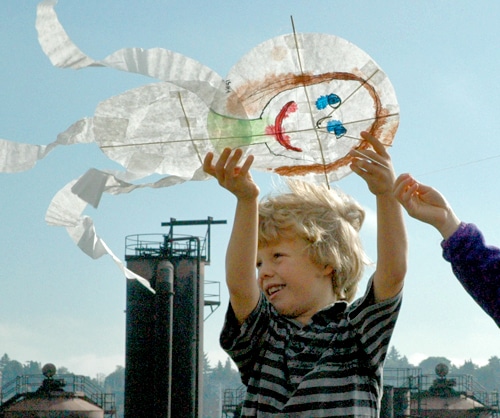


learn more about

learn more about

overview
partner with us
partner with us
events

events



learn more about

learn more about











 At University Child Development School, UCDS, preschool through fifth grade students attend classes in seven specialty areas in addition to core academic subjects in their classrooms. These areas are: Art, Library, Music, Physical Education, Science, Spanish and Technology and Design, and collectively the teachers of these programs are called “the Specialists.” These teachers draw on their areas of expertise and interest to build an engaging and innovative curriculum for students. While the school schedule has separate boxes for each specialist class, in reality it is impossible to contain the disciplines in this way. For example, a song learned in Music class takes on new meaning when the cultural tradition behind the song is uncovered in Spanish class. Though it is tempting to isolate each subject for ease of planning—allowing for a “divide and conquer” approach to curriculum design—we have found it worth the extra effort to build connections between our programs and draw inspiration from the passion and expertise of our colleagues. This culture of collaboration, united around a school-wide theme that we choose each year, is the driving force behind our interdisciplinary curriculum.
At University Child Development School, UCDS, preschool through fifth grade students attend classes in seven specialty areas in addition to core academic subjects in their classrooms. These areas are: Art, Library, Music, Physical Education, Science, Spanish and Technology and Design, and collectively the teachers of these programs are called “the Specialists.” These teachers draw on their areas of expertise and interest to build an engaging and innovative curriculum for students. While the school schedule has separate boxes for each specialist class, in reality it is impossible to contain the disciplines in this way. For example, a song learned in Music class takes on new meaning when the cultural tradition behind the song is uncovered in Spanish class. Though it is tempting to isolate each subject for ease of planning—allowing for a “divide and conquer” approach to curriculum design—we have found it worth the extra effort to build connections between our programs and draw inspiration from the passion and expertise of our colleagues. This culture of collaboration, united around a school-wide theme that we choose each year, is the driving force behind our interdisciplinary curriculum.
For students, engaging in one topic through multiple disciplines facilitates the kind of integrated thinking that is crucial in today’s interconnected world. Strengthening ties between specialty areas allows students to access knowledge through different pathways and gives them multi-sided tools to solve complex problems. We have observed a positive feedback loop when we merge our curricula. For example, during the year themed Vision, students experienced “Ah Ha” moments when they applied principles of light and optics they had learned in Science to glasswork they were creating in Art. Each new window into a topic reinforces the skills developed in other areas, and as students move along an interdisciplinary thread they realize that they’ve begun to think “like the experts.” While they certainly haven’t covered every content area, they have uncovered the kind of in-depth and connected thinking that is necessary to push a field forward.
For the teachers, collaboration has become the fire that fuels some of our most exciting curricular developments. Here we describe two examples that demonstrate how specialist teachers have come together and highlight the processes, insights and curricula that have emerged as a result.
One year, during the school-wide theme Quest, teachers launched a yearlong exploration of guitars with the 4th and 5th grade students. This project brought together Music, Technology, a local sawmill and a luthier (stringed instrument builder). It began in the Specialists’ team conversations before the start of the school year, where Ben Chickadel (Technology and Design) and Matt Swanson (Music) shared their ideas for the year. Ben hoped to explore the quest from raw materials to finished products, and Matt was interested in leading students in a quest to understand how various instruments produce sound. Ben had come across a plan for a build-your-own cigar box guitar in Make magazine, and this was the spark that revealed the potential for collaboration.
They initially envisioned a fairly simple, short-term collaboration, but as new avenues for exploration kept opening up, the scope of the project kept growing. Instead of using pre-made materials and following the prescribed process in the magazine, they decided to take a more comprehensive, holistic approach, which led them right to the very source of the materials: a local saw mill.
At the mill, students were captivated as they hoisted logs in the air and watched the powerful saw shape former trees into guitar necks. Back at school, classes tested the resonance of the cigar boxes that would later become guitar bodies and used Google SketchUp to plan how all of the pieces would fit together. To bring these designs to fruition students used tools such as saws, drills, hammers and less tangible tools like mathematical and spatial reasoning. Grappling with complex fractional equations, one student remarked “I’m not sure if I’m in Math, Music or Technology right now!”
Coordinating the steps of the project required a great deal of planning and conversation between Ben and Matt. “In the beginning, once we realized the scope of the project, we talked whenever we could find time—at lunch, between classes, after school. We needed longer sessions to plan out where to start and where to go. But as the project rolled along, there was a natural sequence to it,” reflected Ben. And, as Matt added, “Each new step presented unique challenges—we had to keep reassessing the timeframe and direction of the project.” Managing these curricular pieces involved frequent, sometimes daily, check-ins.
With the basic shape of the guitars cut and ready, classes took a field trip across the street to visit a guitar-builder in action. Luthier Aaron Andrews explained his process for making various types of guitars and highlighted the different types of materials and tools he used. He then cut the fret slots into the students’ guitar necks—a step requiring specialized tools and a degree of precision that Ben and Matt decided was best left to a professional! Back at school, classes worked through the remaining steps, becoming experts in the specific vocabulary of the trade: notching and gluing necks into bodies, cutting bridges and nuts out of found plastic materials, cutting and filing fret wire and installing tuning pegs. They even built, tested and installed piezo pick-ups so that the guitars could be amplified.
Along the way, there were some logistical obstacles that had to be addressed. Ben remembers, “Sometimes we had to split up the project, and parts were completed either in Music class or Technology class. A few times we had to adjust the schedule and all meet and work together. For the cutting and sawing parts of the project we had to find a space out of the Tech lab where we could do that!” Coordinating field trips with classroom teachers, checking with other specialist teachers to make occasional schedule changes, and finding materials and spaces for the project were challenges that had to be overcome in order to keep the project moving.
The whole process came to fruition just as classes were gearing up for the spring musical performance, and eight students took to the stage with the guitars they had made. As the “guitarchestra” performed a rousing rendition of “On the Road Again,” the crowd marveled at the sound of these handmade instruments. In Music class students spent the rest of the spring playing the guitars, learning chords and basic technique. As the 4th and 5th graders built their set of musical skills, it was evident just how much they had taken from this project. They understood, profoundly, the inner workings of the instruments, and when something broke they knew just what was needed to fix it. They experienced first-hand the quest from raw materials to sophisticated musical instruments so they appreciated the interconnected nature of music, technology, math and product design. And finally, they invested indelibly in a set of instruments that became part of the school’s music collection.

The experience not only facilitated student learning, but also prompted growth and learning on the part of the teachers. Over the year, Matt and Ben experienced how each of their programs was strengthened by removing the division between disciplines through authentic collaboration. In addition, they each were able to learn from the other about the technical and logistical pieces of the project itself. Ben reflected, “I knew I could approach this project in a technical/design way, but I had to learn so much about sound and how a guitar works. I didn’t know anything about that!” Though Matt understood how a guitar was supposed to feel and sound, he had never considered all the technical details of creating one from scratch. By necessity, both teachers learned tremendously from the expertise of the other. They also gained an appreciation for the importance of flexibility in scheduling for a project like this—though they had initially envisioned a straightforward, couple month-long process, the emergent possibilities caused the project to balloon into a full year investigation.
The legacy of the guitars lives on at the school, where they hang on a display wall next to the front office. They are still used for musical pursuits of all kinds, and they also function as a reminder of the opportunities presented by interdisciplinary, collaborative teaching
It is a blustery day on the playground at UCDS and first and second grade student scientists are cheering for the wind to blow even harder. They are using handheld anemometers to record wind speed, analyzing the various designs of these instruments for accuracy and ease of use. Later in the year they will choose the best anemometers for testing windmill blades they have designed in Technology class, and weeks earlier these same students experienced the sensations of the wind as they soared self-portrait kites from Art class high in the sky.
In this collaborative example, the school-wide theme of Design and the topic of wind were the common thread that bound together these interdisciplinary projects. We were initially inspired by the students’ classroom read-aloud Windblowne, a story of a young boy Oliver and his kite-flying adventures. Before the school year started, the Specialists brainstormed how our separate curricula could weave together concepts, skills and processes that could tie into this captivating story. Kites, wind and renewable energy kept coming up in our conversations and the Art, Science and Technology and Design teachers all developed curricula around these themes. While we each had specific plans for our program of study, the common topics and concepts kept us conversing and learning about these subjects together. In these vignettes, we describe how first and second grade students were swept up in a cross-curricular study of wind and weather in Art, Science and Technology and Design classes.
In the Science Lab, students spent several weeks investigating the properties of air and the principles of convection. They explored the design of six different anemometers, examining their form and function and testing them in and out of the lab. A collaboration with a local scientist also added depth to our project. Meteorologist Kristina Katsaros shared equipment and brought to life her experiences as a weather scientist and engineer: living on National Oceanic and Atmospheric Administration (NOAA) ships, simulating wind, rain and ocean interactions in the laboratory, and even flying into a hurricane!
Meanwhile in the Technology Lab, students immersed themselves in a yearlong project on wind and renewable energy. Focusing on wind turbines, students used computers to design and simulate tests for wind generator blades. Each student created a set of unique propellers and measured the voltage output—enough to light an LED. During this project, tools and terms explored in the Science lab were revisited in Technology, while the project in Technology added application and meaning to the concept studies happening in Science. The crossover also greatly benefited the teachers as we shared resources, equipment and insight for topics new to us in this investigation. The side-by-side placement of the Science and Technology labs made it easy to serve as each other’s sounding boards for ideas and curriculum.
In the Art Studio, the year took flight with students designing and building self-portrait kites and overcoming the challenges of aligning a self-portrait with the parts of a working kite. Art teacher Jessica Garrick reflected, “In collaboration with the Drachen Foundation, an organization whose mission is to increase the knowledge of kites worldwide, we designed kites, the shapes of which would accommodate full body self-portraits but which would also function as flying kites. An important aspect of the project for us was allowing the students to express how they saw themselves with drawing and painting on the sails of the kite.” On a culminating field trip to a local park, students flew their kites high in the sky. As they sketched each other’s kites, they noticed the contrast of their creations against the backdrop of clouds and color. “We were all so excited to see these huge self portrait kites soar in the sky. It was the perfect day and the kites looked amazing against the blue sky and clouds.” These observations inspired their next study in Art—skyscapes, with students using oil pastels and watercolors to create resist paintings. They then worked with Jessica and expeditionary artist Maria Coryell-Martin to create watercolor cloudscapes.

Science teacher Katie Morrison reflected, “One day at lunch Jessica started talking about the skyscapes project and I immediately thought—Oh, I want to study clouds in science! This kind of thing happens again and again. You hear about something a colleague is doing with students and think, that sounds really cool, I want to join in. The key is to head down the hall and have those informal chats about curriculum and teaching. Ask, what’s happening in your classroom?”
Back in the Science lab and inspired by the skyscapes, students learned the names and Latin roots of clouds, how to identify different cloud types, how to determine opacity, and how to estimate cloud cover. Students submitted their observations and data to NASA’s Students Cloud Observations Online (S’COOL) program. Observation skills and cloud terminology were reinforced in Science and Art as students explored clouds and weather from multiple perspectives. For the teachers, we were inspired by each other’s work and our conversations led to new teaching opportunities.
While each project in Art, Science and Technology could have stood alone as an interesting investigation of design, weather and wind, together they harnessed the energy of collaboration and the benefits for students and teachers of exploring a topic through multiple perspectives and disciplines.
From these experiences, as well countless other projects, we carry forward some important lessons. The crucial ingredient is a willingness to start fresh each year and consider new opportunities for exploring each discipline through different lenses—it is always exciting to see where the new theme and new school year will take us. We have also found that it is difficult to initially map out every detail for projects of this magnitude—rather it is beneficial to let the projects unfold in response to student learning, teacher collaboration and out-of-school resources. Flexibility in scheduling is another important component to successful collaborations. Our schedule is a complex array of classes that don’t always match up with each other; we each teach multiple levels in the school for varying amounts of time and differing numbers of weekly classes. However, when opportunities arise for combined classes, field trips or special projects we let go of these boxes and are grateful for the flexibility of our colleagues whose schedules are also impacted. Successful collaborations require flexibility in planning as well, adjusting the curriculum to coordinate with our partner’s, while also keeping in mind the specific needs of our own program. At times it can also be necessary to let go and proceed in our own direction when the timing or direction of the project doesn’t work out.
Lastly, frequent conversations are central to successful partnerships, as these facilitate consistencies in student experiences and enable the reinforcement of concepts and ideas across subject areas. These collaborative discussions revolve around big picture ideas such as themes, project directions and learning outcomes, as well as the nuts and bolts of a project such as tools, materials and terminology. While our collaborations are certainly facilitated by weekly meetings of the Specialist team, it is the casual conversations in the hallway, lunchroom and after school that often spark the most interesting projects. Creating and sustaining a culture of interaction between teachers, such that the activity in each room becomes the interest of everyone, is really what allows these conversations to happen.
Collaborations can be a tight knit plan where two curricula are linked and sewn together, each depending on the others’ progress to move forward. Other times, they are strung together by a common thread or idea, each flowing freely like a kite tail but also building on one another and each adding a layer of depth to the concept study. Either form is inspiring to teachers and students alike!
Messer, Stephen. (2010). Windblowne. New York: Random House Book for Young Readers.*
NASA S’COOL program. Retrieved from https://scool.larc.nasa.gov.
The Drachen Foundation. Retrieved from https://drachenkite.com/about-us/.
Vogel, Ed, (2005). Cigar Box Guitar: Build and play sweet sounding 3 string instrument. Make.
To learn more about University Child Development School, visit: https://www.ucds.org/